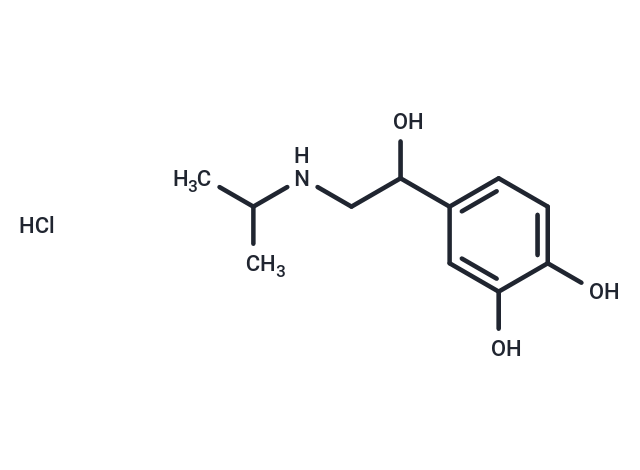Shopping Cart
- Remove All
 Your shopping cart is currently empty
Your shopping cart is currently empty

Isoprenaline hydrochloride (NCI-c55630) is a potent beta-adrenergic agonist with the peripheral vasodilator, bronchodilator, and cardiac stimulating properties.

| Pack Size | Price | Availability | Quantity |
|---|---|---|---|
| 1 g | $33 | In Stock | |
| 1 mL x 10 mM (in DMSO) | $30 | In Stock |
| Description | Isoprenaline hydrochloride (NCI-c55630) is a potent beta-adrenergic agonist with the peripheral vasodilator, bronchodilator, and cardiac stimulating properties. |
| In vitro | Incubation of intact rat fat cells with isoprenaline (300 nM, 3 min) increased particulate cGMP- and cilostamide-inhibited, low-Km cAMP phosphodiesterase (cAMP-PDE) activity by about 50% and 100%, respectively [1]. Relaxation induced by isoprenaline was also potentiated by the cyclic GMP-inhibited PDE (PDE 3) inhibitor cilostamide (100 nM). Isoprenaline (5 nM and 10 microM) increased cyclic AMP levels and this effect was potentiated by cilostamide (10 microM), by rolipram, a cyclic AMP-specific PDE (PDE 4) inhibitor (10 microM) and by cyclic GMP-elevating agents (50 nM ANF or 30 nM SNP plus 100 nM DMPPO) [2]. Isoprenaline increased the phosphorylation levels of Akt, and the downstream FoxO1, FoxO3a, and CREB. When catecholamine binding to β-adrenoceptors, the G protein–coupled receptor kinase-2 (GRK2) mediates the translocation of PI3K to β-adrenoceptors and then enhances the recruitment of β-arrestin and AP-2, which finally results in the internalization and downregulation of β-adrenoceptors. It has reported that disrupts the interaction between PI3K and GRK2 by displacing class I PI3K isoforms blocks agonist-stimulated β-adrenoceptors internalization [3]. |
| In vivo | METHODS: To induce a model of pathological cardiac remodeling, Isoprenaline hydrochloride (1.5 mg/kg in NaCl 0.9%) was injected subcutaneously into C57BL/6 mice once a day for ten days. RESULTS: Cardiac structural abnormalities (increased IVSTd and LVPWd), impaired cardiac function (EF and CO), and elevated heart weight/body weight ratios (HW/BW) were seen in Isoprenaline-administered mice. [3] |
| Cell Research | Cells are seeded in 24-well culture dishes at a density of 2 to 5×10^4 cells per well. Experiments are performed after 3 to 5 days in culture when cells has reached confluence. Culture medium is aspirated and replaced by 0.5 mL of PBS containing the pharmacological agents. Treatments are performed in quadruplicate at 37°C. The type 3, 4 and 5 PDE inhibitors cilostamide (10 gM), rolipram (10 pM) and DMPPO (10 gM), respectively, are incubated with cells for 30 min before addition of adenylate or guanylate cyclase activators. Cyclic GMP and cyclic AMP are respectively increased in RASMC by stimulation of particulate guanylate cyclase with ANF (50 nM for 10 min) or fl-adrenoceptors with isoprenaline (5 nm for 5 min). At the end of the incubation period, the medium is removed and intracellular cyclic nucleotides are extracted by two ethanolic (65%) ishes at 4°C for 5 min. Ethanolic extracts are pooled, evaporated to dryness by a Speed-Vac system. The dried extract is dissolved in a suitable amount of assay buffer and cyclic nucleotide levels are measured by scintillation proximity assay [3]. |
| Alias | NCI-c55630, Isoproterenol hydrochloride, Isoprenaline HCl |
| Molecular Weight | 247.719 |
| Formula | C11H18ClNO3 |
| Cas No. | 51-30-9 |
| Smiles | Cl.CC(C)NCC(O)c1ccc(O)c(O)c1 |
| Relative Density. | 1.2296 g/cm3 (Estimated) |
| Storage | Powder: -20°C for 3 years | In solvent: -80°C for 1 year | Shipping with blue ice. | |||||||||||||||||||||||||||||||||||
| Solubility Information | H2O: 50 mg/mL (201.84 mM), Sonication is recommended. DMSO: 60 mg/mL (242.21 mM), Sonication is recommended. | |||||||||||||||||||||||||||||||||||
Solution Preparation Table | ||||||||||||||||||||||||||||||||||||
H2O/DMSO
| ||||||||||||||||||||||||||||||||||||

Copyright © 2015-2025 TargetMol Chemicals Inc. All Rights Reserved.